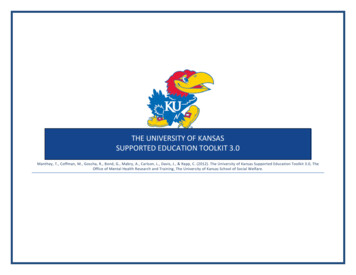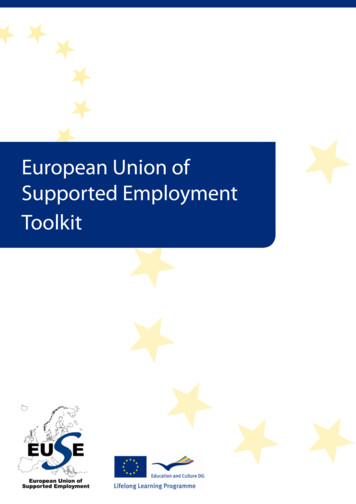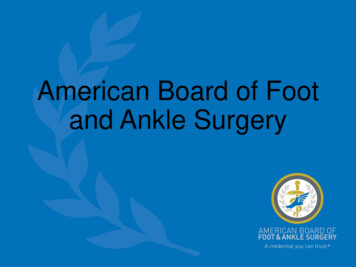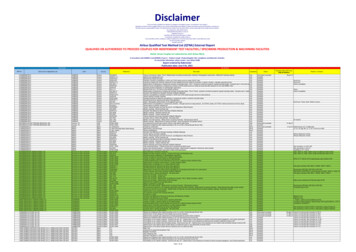
Transcription
Building a Qualified and SupportedEarly Care and Education WorkforceA Primer for Legislators NOV 2018
Building a Qualified and SupportedEarly Care and Education Workforce:A Primer for LegislatorsBY JENNIFER PALMERThe National Conference of State Legislatures is the bipartisanorganization dedicated to serving the lawmakers and staffs of thenation’s 50 states, its commonwealths and territories.NCSL provides research, technical assistance and opportunities forpolicymakers to exchange ideas on the most pressing state issues,and is an effective and respected advocate for the interests of thestates in the American federal system. Its objectives are: Improve the quality and effectiveness of state legislatures Promote policy innovation and communication amongstate legislatures Ensure state legislatures a strong, cohesive voice in thefederal systemThe conference operates from offices in Denver, Colorado andWashington, D.C.NATIONAL CONFERENCE OF STATE LEGISLATURES 2018iiiNATIONAL CONFERENCE OF STATE LEGISLATURES
IntroductionExtensive research on early brain development underscores the importance of the first few years of achild’s life. Decades of research shows that positive relationships between young children and their caregivers are critical for supporting healthy social, emotional and cognitive development.1 While parents playthe most essential role in supporting their child’s development, most families must also entrust the careof their children to early care providers and educators while they work.2 Because children learn and growwherever they are and every interaction with a caregiver affects their development, a well-qualified andsupported workforce is essential to ensure early learners are set up for success in school, work and beyond.An estimated 10 million children from birth to age 5 spend time incenter- or home-based early care and education (ECE) settings eachday.3 Parents responding to the 2012 National Survey of Early Careand Education (NSECE) reported using some type of non-parentalcare for children from birth to age 2 for an average of 34.9 hours aweek and 31.6 hours a week for children aged 3 to 5 years.4Research links high-quality early care and education to positivechild outcomes, including school readiness, reduced spending onremedial education, positive social behaviors and increased earnings over a lifetime.5 This is especially true for children from low-income neighborhoods and for dual-language learners.6 For manyfamilies, however, high-quality early care and education is financially out of reach and difficult to access due to a lack of providers—particularly in rural areas and for parents with non-standard workhours—and limited enrollment opportunities.Enrollment fees are the primary source of revenue for ECE providers. Parents pay an average of 9,000 to 9,600 per year for childcare for just one child, accounting for nearly 11 percent of the median income for married parents with children younger than 18. Theaverage cost of care is much higher in some states and higher stillfor infant care.7 While these fees stretch many families’ budgets tothe brink, most providers are barely making ends meet. The mostlyfemale workforce typically earns low wages, has little or no accessto benefits and often relies on public assistance to support themselves and their families.8 Moreover, low compensation for ECEworkers does not align with research that shows an effective workforce is the “single most important factor” in providing high-qualityearly care and education.9“ Despite research recognizingthe importance of high-qualityearly education to healthy childdevelopment, and researchthat indicates that high-qualityproviders and educators are thesingle most important factorsin these early experiences, toomany individuals within the earlylearning workforce earn lowwages—sometimes at or nearthe federal poverty line—evenwhen they obtain credentials andhigher levels of education.”—”High-Quality Early Learning SettingsDepend on a High-Quality Workforce:Low Compensation Undermines Quality”,U.S. Department of Human Services andU.S. Department of EducationFederal, state and local dollars are used in a variety of ways to improve quality and expand access to earlycare and education, including preparing and supporting the ECE workforce. As some states increase theirinvestments in state-funded prekindergarten, they are also considering the preparation, support and retention of ECE workers. The Child Care Development Fund (CCDF), the largest federal funding stream forchild care, is administered by states and provides financial assistance to low-income families to access childcare so parents can work or attend a job training or educational program. A 2017 increase of 5.8 billion tothe CCDF provides new opportunities for states to further invest in high-quality early care and educationand the ECE workforce.State legislators, in partnership with their state’s leaders in early childhood, higher education, K-12 education and workforce development, play an important role in supporting the workforce that cares for andteaches early learners. Increases in state and federal funding, combined with a shortage in teachers nationwide, a decline in home-based child care, and the expected increased demand for 600,000 additional ECE workers by 2024,10 are prompting legislators in Illinois and other states to take a deeper look at thechallenges of growing, retaining and compensating a high-quality ECE workforce.1NATIONAL CONFERENCE OF STATE LEGISLATURES
What do we know aboutthe ECE workforce?Center-based Workforce by Setting6%SchoolsponsoredThe ECE workforce cares for children birth toage 5 in center-based for-profit and nonprofit programs, home-based care settings, HeadStart classrooms, and publicly funded andschool-sponsored prekindergarten classrooms.All settings—whether a classroom, home orcenter—are part of the ECE system.14%ECE workers include caregivers, teachers,classroom aids and administrators. They meetchildren’s most basic needs (e.g., diapering,feeding and bathing), implement age-appropriate curriculum, and manage and administer programs. Altogether, an estimated 4.8million workers are employed in ECE roles inthe United States.11 The majority, 3.8 million,are home-based providers and may be eitherlicensed or unlicensed, as well as paid or unpaid. About 1 million are center-based, whichincludes private and community-based programs, and school-sponsored, Head Start andpublic prekindergarten classrooms. This report refers only to the paid ECE workforce.Head Start59%21%All otherPublic pre-KSource: National Survey of Early Care and EducationThe ECE workforce is predominately female andis more racially and linguistically diverse than the U.S. workforce at large. Forty percent of ECE workers arepeople of color and 27 percent speak a language other than English.12Wages vary across settings and funding sources but almost always are extremely low and sometimes ator below the federal poverty level.13 ECE workers are generally paid hourly and earn a median 10.72 perhour, or 22,290 a year. Center-based providers working with infants and toddlers typically earn the lowest wages while workers in school-sponsored prekindergarten classrooms typically earn the highest wages.As shown in the table below, these wages are well below the median for educators of older children andworkers in other occupations.14Employment conditions vary across ECE settings but often include long hours, particularly for home-basedworkers, and undependable schedules. ECE workers are generally not paid for planning or professional development as is common for educators of older children. About three-fourths of ECE workers report havingMedian Hourly Wages by Occupation, 2017Child careworkers,all settingsSelfemployedhome careprovidersPreschoolteachers, allsettingsPreschoolteachers inschools onlyPreschool/child carecenterdirectors, lloccupations 10.72 10.35 13.94 26.88 22.54 31.29 32.98 18.12Note: All teacher estimates exclude special education teachers. Hourly wages for preschool teachers in schools only; kindergarten and elementary school teachers were calculated by dividing the annual salary by 40 hours per week, 10 months per year, in order to take into account standards school schedules. All other occupations assume 40 hours perweek, 12 months per year.Source: Center for the Study of Child Care EmploymentNATIONAL CONFERENCE OF STATE LEGISLATURES2
Workforce DataNearly every state has an ECE workforce registry that collects data such as workerdemographics, place of employment and role, benefits and wages, training andeducation, as well as turnover and retention. Although the types of data captured varyfrom state to state, the overarching purpose of collecting data is to help administrators,funders and policymakers understand the status and needs of the ECE workforce and iscritical to inform policy and quality initiatives.In some states, data is limited because participation is voluntary or does not includeworkers in unlicensed settings unlicensed settings, according to the Center for theStudy of Child Care Employment Workforce Data Deficit Report. Illinois and Oregon useregistry data to evaluate and report on trends in their ECE workforce annually. Datacollected through workforce registries may also be used by administrators and workersto track professional development, qualifications for licensing, accreditation and qualityrating improvement systems (QRIS).Additionally, more than half of all states have conducted ECE worker surveys. Recentsurveys in Colorado and Nebraska were used to identify challenges and opportunities tosupport, grow and retain ECE workers in their states.some form of health insurance, either through their employer, a spouse or purchased individually.15 Surveys in four states—Iowa, Illinois, North Carolina and Virginia—found that 59 percent to 72 percent of ECEworkers in centers have paid sick leave.16 Home-based workers, who often work alone, are less likely to receive employment benefits.17As a result of low wages, 46 percent of the ECE workforce is enrolled in at least one public support program—for example, federal Earned Income Tax Credit (EITC), Medicaid and Children’s Health InsuranceProgram (CHIP), Supplemental Nutrition Assistance Program (SNAP) or Temporary Assistance for NeedyFamilies (TANF)—compared to 34 percent of preschool and kindergarten teachers and 13 percent of elementary and middle school teachers. The estimated cost of public benefits for ECE workers and their families is 1.5 billion a year.18Preparing and Supportingthe ECE WorkforceUnlike educators of older children, there is no widely accepted preparation standard or minimum education requirement for the workers caring for and teaching children younger than 5. Although research underscores the importance of a child’s first years in establishing a solid foundation for learning, preparationrequirements for ECE workers are inconsistent and vary by age of children served, setting, and within andacross state lines. An estimated 9 percent to 17 percent have earned an associate degree, and 15 percentto 35 percent have a bachelor’s degree or higher.19Higher education and formal training typically do not pay off financially for ECE workers the way they dofor employees in other sectors. While higher educational attainment is indeed linked to higher earnings forECE workers, they are still paid significantly less than educators working with older children or workers inother fields with comparable education levels. When comparing the mean annual salary of an ECE workerwith a bachelor’s degree to that of other educators and workers in the civilian labor force with equivalenteducations, it becomes clear that a bachelor’s degree in early childhood education has “the lowest lifetimeearnings projection of all college majors.”203NATIONAL CONFERENCE OF STATE LEGISLATURES
Mean Annual Salary of Teachers with a Bachelor’s or Higher Degreeby Occupation and for the Civilian Labor Force, 2012All otherECEteachersworkingwith ages0-3All otherECEteachersworkingwith ages3-5Head ersCivilianlabor force,womenCivilianlabor force,men 27,248 28,912 33,072 33,696 42,848 53,030 56,130 56,174 88,509Note: “All other” includes teachers working in center- and home-based settings.Source: Center for the Study of Child Care EmploymentWhere do states currently stand onpreparation standards for ECE workers?Many ECE workers do not complete preservice education and may not complete formal training or education until they are on the job.21 Education requirements for ECE workers vary among roles and settings,resulting in a wide range of competencies among workers. Although specialized trainings and early childhood credentials are offered in all 50 states, Washington, D.C., and Puerto Rico,22 most states require nomore than a high school diploma to work with infants and toddlers. Nearly half of all states require bachelor’s degrees for teachers in state-funded prekindergarten classrooms. Another four states require at leastan associate degree to teach in state-funded prekindergarten classrooms, according to the National Institute for Early Education Research.Similarly, at least 50 percent of Head Start classrooms, with children ages 3 to 5 years, are required to havea lead teacher with a bachelor’s degree. Head Start assistant teachers must have at least a Child Development Associate (CDA) credential or earn the credential within two years of their start date.23 ECE workersin Washington, D.C., and Connecticut face the most rigorous requirements. A recently enacted policy fromthe Washington, D.C., superintendent of education will require lead teachers across all ECE settings to haveat least an associate degree by December of 2023 and all assistant teachers and home-based providers tohave at least a CDA by December of 2019.24Lawmakers in Connecticut approved a measure to require that by 2020, at least one ECE worker in eachclassroom across all settings have at least a CDA and 12 credits in early childhood education or development. Programs receiving state funds will require all lead teachers to have a bachelor’s degree by 2023, according to the Connecticut Office of Early Childhood.Nearly all states (47), as well as D.C. and Puerto Rico, have established core competencies for the ECE workforce that include child growth, development, family engagement, health and safety. These competenciesusually are developed by a state agency or partnership of agencies or an early childhood advisory council.Colorado’s Competencies for Early Childhood Educators and Administrators, put forth by the state’s EarlyChildhood Leadership Commission, outline the knowledge and skills ECE workers should have to providehigh-quality care and education. There is concern in the field that core competencies for ECE workers areoften not enforced, well-integrated into ECE systems, or even well-communicated to the ECE workforce orthose hiring and training ECE workers.25What are the barriers to attaining additionaleducation for ECE workers?While almost all experts agree that more needs to be done to prepare ECE workers and support their ongoing professional development, there is debate among academics, policymakers and practitioners aboutthe optimal level of ECE worker preparation to ensure positive outcomes for children. A recent consensusNATIONAL CONFERENCE OF STATE LEGISLATURES4
How do states use their Quality Rating Improvement Systemto support the ECE workforce?All states, plus Washington, D.C., and Puerto Rico, have implemented or are in theplanning stages of establishing a Quality Rating Improvement System (QRIS) to evaluateand support quality in early care and education in centers and homes. Providers areevaluated in several categories, including learning environment, child safety, familyengagement, administration and workforce qualifications. Nearly all systems evaluateand award points based on the training and educational attainment of ECE workers.Other worker-related QRIS criteria include: Workers’ use of a state’s ECE career pathway (also referred to as career ladders orlattices)Years of experienceMembership in a professional organizationProviding benefits, paid planning time, evaluations and other supports to workersAdditionally, many QRIS offer bonuses or scholarships for ECE workers to improve theirprogram’s rating through increased education or training.Source: National Center on Early Childhood Quality Assurancestudy report argues the standards for early childhood educators should be elevated to those of educatorsworking with older children by increasing minimum education requirements for lead early childhood educators to a bachelor’s degree.26 Other researchers have found that on-the-job training or coaching havegreater impacts on positive child outcomes.27 There is also debate about the ages when children most benefit from teachers having advanced training or degrees.ECE workers pursuing additional education face significant barriers, perhaps the greatest being the cost ofhigher education. Because ECE workers typically earn poverty-level wages, they likely must work while attending classes. This may pose scheduling challenges and impede their ability to take out student loans.Also, some current ECE workers are “nontraditional students” and require remedial education and other supports, including English language support and academic and career counseling from a counselor familiar with the ECE field.28 In addition, variations in standards and training requirements among providers,programs and states pose challenges for ECE workers moving or changing employers.Finally, variation in pay across ECE settings means workers who obtain additional education might leavetheir roles for higher paying positions, further fueling the already high turnover in the ECE field. For example, a worker in an infant and toddler room who earns a bachelor’s degree could then seek a positionworking with older children in a prekindergarten room where she can earn higher wages. There is concernamong some in the field that this type of turnover may make employers less likely to support or offer incentives to workers to pursue higher education.29 Bright Horizons, an ECE provider with locations acrossthe country, has a plan of its own. The company announced it will provide free college tuition to workerspursuing an associate or bachelor’s degree.What are states doing to prepare ECE workers?And how are they funding these efforts?Preparation and training for ECE workers comes in many forms and often those participating are alreadyworking in the field. Policymakers looking to build a well-qualified ECE workforce must therefore supportthe training and educational advancement of both current and future workers. States are doing this by investing in scholarships, apprenticeships and coaching, offering credit for prior learning, and improving articulation among institutions of higher education.5NATIONAL CONFERENCE OF STATE LEGISLATURES
SCHOLARSHIPSNearly all states offer scholarships to support the preparation of ECE workers, many of them through theT.E.A.C.H. Early Childhood Program. T.E.A.C.H. partners with organizations in 20 states and WashingtonD.C., and is funded with private and public dollars. States use CCDF funds to invest in high-quality early care and education by building the skills and qualifications of the workforce through T.E.A.C.H. scholarships. Recipients pursue additional education, receive support from career and academic counselors,earn bonuses or raises upon completion of credits, and agree to remain with their employer for a certainamount of time.30Virginia uses CCDF dollars to support the Virginia Child Care Provider Scholarship Program (VCCPSP). Undergraduate students who currently work in the ECE field, or intend to upon graduation, can use the VCCPSP scholarship to pay for classes that lead to a certificate or degree in early childhood education. The statealso funds scholarships through Project Pathways, which awards scholarships to current ECE workers pursuing an early childhood credential or degree at one of Virginia’s community colleges. Priority is given toECE workers working with at-risk children. In Maine, students enrolled in one or more early childhood education or development courses at an accredited higher education institution are eligible for the state-funded Quality Child Care Education Scholarship. Legislatures in both Maine and Pennsylvania extend studentloan forgiveness to child care providers.ARTICULATION AGREEMENTSAt least four states, including Connecticut, Indiana, New Mexico and Pennsylvania, have implemented statewide articulation agreements to enable students to easily transfer credits between highereducation institutions.31 Indiana’s legislature tasked its higher education leaders with developing theTransfer Single Articulation Pathway, which creates a formal partnership between the state’s publictwo-year and four-year colleges. Students with up to 60 credits from a community college can nowenroll in one of Indiana’s state universities to complete their Bachelor of Science in early educationwithout losing any credits. At least three states, including Oregon, New Jersey and Wisconsin, ensurecredit for prior learning. ECE workers pursuing a child development associate certificate at a community college in these states can receive credit for their work experience if they demonstrate proficiency and meet other requirements.APPRENTICESHIPSHelping current ECE workers further their education while continuing to work creates a more qualifiedworkforce while reducing turnover and instability in the field. This approach has led policymakers in somestates to expand apprenticeship opportunities in which ECE workers get on-the-job training while completing related coursework. State dollars are used to fund ECE apprenticeship programs in Vermont, Virginiaand West Virginia.COACHINGMany ECE programs offer coaching to their employees, especially those new to the field. Coaching involvesan experienced educator, often with an advanced degree, who conducts observational assessments in theclassroom and provides individualized feedback to the worker. Research demonstrates that coaching produces positive outcomes for both ECE workers and the young children they serve.32 State dollars in NewJersey and North Carolina are used for coaching in public prekindergarten classrooms. In Washington andMichigan, ECE workers in state-funded prekindergarten classrooms and child care centers, and participating in the state’s QRIS, receive coaching.33What are the barriers to increasingcompensation for ECE workers?For child care programs, one factor contributing to low wages is the below-market rate states offer toearly care providers serving families receiving child care assistance. States use federal CCDF funds andstate dollars to fund child care assistance for low-income families who qualify. Rates vary by location;however, all states calculate their provider payment rate as a percentage of the market rate. The fedNATIONAL CONFERENCE OF STATE LEGISLATURES6
Department of Defense and Head StartTwo national ECE programs use a combination of training, education, coaching andcredentialing to attain highly qualified workers. The Department of Defense’s child caresystem moves ECE workers through a professional pathway that ties incremental stepsto compensation. The path includes basic training, Child Development Associate (CDA)credential, associate degree and then bachelor’s degree. Education is coupled withrequirements to demonstrate competencies, continued training and coaching.Head Start teachers have access to continuous coaching and professional developmentopportunities. Seventy-three percent of Head Start’s lead teachers have a bachelor’sdegree or higher and 96 percent have an associate degree or higher.erally recommended reimbursement rate is 75 percent of the market rate; however, only two states,South Dakota and West Virginia, pay at this recommended level. The remaining states are below orsignificantly below the federally recommended level. In some states, this means low-income familiesmay have to pay the difference or another amount as a co-pay. Payment rates impact not only providers’ income, but also their ability to hire and adequately compensate high-quality staff.34 Furthermore, long hours and low adult-to-child ratio requirements mean high labor costs, particularly forworkers serving the youngest children.35Most early care and education is unsubsidized, meaning parents shoulder the cost. And although the U.S.Department of Health and Human Services defines “affordable child care” as 7 percent of a family’s income, many families pay much more than this standard nationwide; 1 in 3 families spend 20 percent oftheir income on child care while 1 in 5 spend a quarter.36 Single parent families pay an average of 35 percent.37 Raising wages for ECE workers would likely mean shifting the cost to parents who cannot afford topay any more.What are states doing to addresscompensation issues for ECE workers?Researchers contend that low wages contribute to high turnover, economic instability and stress for ECEworkers, which in turn negatively impacts the quality of care they provide and outcomes for children. Aspart of their efforts to improve early care and education, some states are looking at what can be done toaddress compensation issues for this critical workforce.FINANCIAL INCENTIVESECE workers in some states receive financial supplements in the form of bonuses, stipends or taxcredits upon obtaining additional education or training and increasing their tenure in the ECE field.Thirty-three states provide bonuses for ECE workers, often in the form of a one-time payment forcompleting an ECE certification or degree. Bonuses are often tied to a state’s scholarship program.ECE workers in 12 states are eligible for stipends for continuing to stay in their position or completingadditional ECE coursework.38The five states (Delaware, Florida, Iowa, North Carolina and Washington, D.C) with the WAGE stipendprogram, for example, are placed on a “salary supplement scale” that rewards workers for obtaininghigher levels of education and for remaining in the same child care setting.39 Like T.E.A.C.H. scholarships, WAGE is a project of the Child Care Services Association but is administered by state-level organizations and funded through federal, state and local dollars.40 Similarly, an eligible ECE worker inWisconsin could receive a stipend of 100 to 900 through the state’s REWARD program funded bythe Legislature. Georgia’s INCENTIVES program distributes a limited number of payments of 250 to 1,250 to ECE workers who meet education and tenure requirements.7NATIONAL CONFERENCE OF STATE LEGISLATURES
Legislatures in Louisiana and Nebraska provide tax credits for qualifying ECE workers who meet certain education or training requirements. In both states the tax credits increase as a worker’s education level increases. In 2014, more than 3,500 directors and staff used Louisiana’s tax credit. The costto the state was 8 million.41PAY PARITYIn some states, preschool educators who work with 3- to 5-year-olds in center-based classrooms can earndifferent wages than their peers working in school-based classrooms, even though both may receive public funding. Similarly, preschool educators in school-based classrooms can earn different wages and receivedifferent benefits than their colleagues down the hall who teach older children. Policymakers are attempting to address these variations in compensation across settings by implementing pay parity policies. 42At least 18 states have established some level of pay parity for preschool teachers. If and how benefits, salary schedules and prorating of wages to account for differences in the number of hours in the classroom(e.g., preschool teachers working 12 months a year vs. 10 months for teachers of older students) are included in their pay parity policies varies state to state. Still, earnings for preschool teachers in these statesare higher than in states without pay parity policies.43Pay parity policies often are set by school districts or administrative codes; however, legislators can alsoplay a role. Lawmakers in Georgia and Alabama approved budget increases to fund salary supplements orincreases to further align the salaries of prekindergarten teachers with public K-12 teachers.44 In 2015, Oregon’s HB 3380 directed the state’s Early Learning Council to create target salary requirements “comparableto lead kindergarten teacher salaries in public schools” for preschool teachers in state-funded classrooms.The language was later changed to, “target salary guidelines shall be, to the extent practicable, comparableto lead kindergarten teacher salaries in public schools.”45No states have extended pay parity to prekindergarten teachers within private settings46 or to other ECEworkers beyond prekindergarten teachers. Researchers at the Center for the Study of Child Care Employment report that Delaware and Washington D.C., are the only states with compensation guidelines forECE workers outside of public prekindergarten, although 13 states have plans to establish compensationguidelines.47Compensation also includes benefits such as health insurance, retirement and paid time off. Researchersstudying pay parity for ECE workers also include paid planning time, paid training time and a dependableschedule in their definition of employment benefits. Using this more comprehensive definition of compensation parity (wages, benefits and paid time for additional responsibilities), researchers found that atleast 10 states offered complete compensation parity for some prekinderga
care so parents can work or attend a job training or educational program. A 2017 increase of 5.8 billion to the CCDF provides new opportunities for states to further invest in high-quality early care and education and the ECE workforce. State legislators, in partnership with their state's leaders in early childhood, higher education, K-12 edu-











